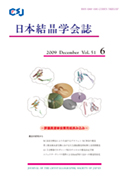All issues

Predecessor
Volume 51, Issue 6
Displaying 1-9 of 9 articles from this issue
- |<
- <
- 1
- >
- >|
-
2009Volume 51Issue 6 Pages Cover06
Published: December 30, 2009
Released on J-STAGE: December 01, 2010
JOURNAL FREE ACCESSDownload PDF (117K) -
2009Volume 51Issue 6 Pages Annc06
Published: December 30, 2009
Released on J-STAGE: December 01, 2010
JOURNAL FREE ACCESSDownload PDF (173K) -
2009Volume 51Issue 6 Pages Index06
Published: December 30, 2009
Released on J-STAGE: December 01, 2010
JOURNAL FREE ACCESSDownload PDF (257K)
Articles
-
Wataru NORIMATSU, Michiko KUSUNOKI2009Volume 51Issue 6 Pages 313-319
Published: December 30, 2009
Released on J-STAGE: December 01, 2010
JOURNAL FREE ACCESSAtomic-scale structure of the interface between graphene and SiC(0001) has been investigated using high-resolution transmission electron microscope observation. Our analysis revealed the presence of two types of the interface structure ; one is formed by decomposition of three SiC bilayers, and the other is formed by that of one SiC bilayer. Formation process of graphene layers on SiC is also described.View full abstractDownload PDF (1957K) -
Akihiko MACHIDA, Tetsu WATANUKI, Katsutoshi AOKI2009Volume 51Issue 6 Pages 320-326
Published: December 30, 2009
Released on J-STAGE: December 01, 2010
JOURNAL FREE ACCESSPressure-induced structural transition of rare-earth metal hydride, YH3, has been investigated by synchrotron radiation X-ray diffraction experiments. We observed the pressure-induced structural transformation from the hexagonal metal lattice into an fcc one through an intermediate state, which appears in the wide pressure span of 12∼22 GPa. The obtained X-ray diffraction patterns in the intermediate state are represented by long-period structures, e.g. 27R, of the yttrium metal lattice. These long-period structures are interpreted in terms of the periodic arrangements of hexagonal-type and fcc-type stacking layers of the yttrium metals. Such structural transition is considered to be characteristic for rare-earth metal hydride.View full abstractDownload PDF (1362K) -
Michihiro SUGA, Shoji MAEDA, So NAKAGAWA, Eiki YAMASHITA2009Volume 51Issue 6 Pages 327-333
Published: December 30, 2009
Released on J-STAGE: December 01, 2010
JOURNAL FREE ACCESSGap junctions, which consist of arrays of intercellular channels, permit the exchange of ions and small molecules between adjacent cells. Here, we describe the structural determination of a gap junction channel composed of connexin 26 at 3.5 Å resolution. During each step of the purification process, the protein was examined using electron microscopy and/or dynamic light scattering. Dehydration of the crystals improved the resolution limits. Phase refinement using multi-crystal averaging in conjunction with non-crystallographic symmetry averaging resulted in an electron density map for model building. The amino-acid sequence of a protomer structure was assigned to the electron density map.View full abstractDownload PDF (1778K) -
Leonard M. G. CHAVAS, Kentaro IHARA, Masato KAWASAKI, Soichi WAKATSUKI2009Volume 51Issue 6 Pages 334-339
Published: December 30, 2009
Released on J-STAGE: December 01, 2010
JOURNAL FREE ACCESSAn increasing number of Rab GTPases associated with partial dysfunction has been linked to several human diseases characterized by a diminution in vesicle transport. Due to its direct implication in human disorders, the Rab27 subfamily is considered as a standard for vesicle docking studies. By which mechanism Rab27 effectors distinguish among the pool of Rab GTPases? What is the underneath machinery rendering the interaction of eleven distinct effectors specific of Rab27 when compared to other Rabs of the secretory pathway? By solving the X-ray structures of Rab27, both in its inactive form and active form bound to the effector protein Slp2-a, attempts have been given to unravel the molecular basis of regulation of the delivering process of vesicles to fusion by the Rab27 subfamily.View full abstractDownload PDF (600K)
-
2009Volume 51Issue 6 Pages 340
Published: December 30, 2009
Released on J-STAGE: December 01, 2010
JOURNAL FREE ACCESSDownload PDF (189K) -
2009Volume 51Issue 6 Pages News06
Published: December 30, 2009
Released on J-STAGE: December 01, 2010
JOURNAL FREE ACCESSDownload PDF (476K)
- |<
- <
- 1
- >
- >|